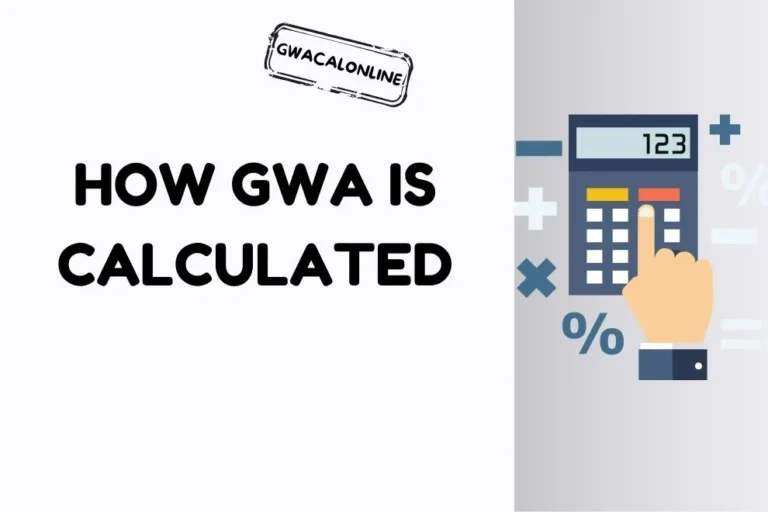In the academic world, especially in college, performance is often quantified through various metrics, one of the most significant being the General Weighted Average (GWA).
Understanding what GWA is and how it affects your academic journey is crucial for every student aiming for success in their studies. But what is GWA exactly?
The General Weighted Average is a numerical representation of a student’s academic performance, calculated by considering the grades received in courses and the corresponding credit units for each subject.
In the Philippines, universities and colleges commonly use this metric to assess a student’s overall performance across multiple semesters.
Unlike simple averages, GWA takes into account the weight of each course, ensuring that subjects with more units have a greater impact on the final result.
For instance, if a student receives a high grade in a subject worth many units, that grade will significantly elevate their overall GWA.
Conversely, a lower grade in a subject with fewer units will have less effect. This nuanced calculation encourages students to focus on their performance in all subjects while considering the weight each subject carries.
Understanding what GWA is also helps students set realistic academic goals. By monitoring their GWA throughout their studies, students can identify areas needing improvement and adjust their study strategies accordingly.
Furthermore, many scholarships, academic honors, and even program admissions hinge on maintaining a specific GWA, making it essential to grasp this concept fully.
What is GWA in College?
When you enter college, understanding how your academic performance is measured is essential for your success.
One of the key metrics used in many educational institutions is the General Weighted Average (GWA). So, what is GWA in college, and why is it important?
Sometime students make common mistake computing GWA which is so common.
General Weighted Average (GWA) is a numerical representation of a student’s overall academic performance. It takes into account the grades you receive in your courses and the number of units each course carries.
Unlike a simple average, where all grades are treated equally, GWA considers the weight of each subject.
This means that a grade in a more challenging or longer course will impact your overall GWA more than a grade in a shorter or easier course.
Understanding How GWA Works
To better understand what GWA is, let’s break it down:
Grades
Each course you take will have a final grade, usually expressed on a scale from 1.0 to 5.0 in many colleges in the Philippines. A lower number indicates a better performance (for example, 1.0 is an excellent grade).
Credit Unit
Each course has a set number of units that reflect its difficulty and time commitment. Generally, subjects that require more class hours and work will have higher unit values.
Calculating GWA
The GWA is calculated by multiplying each grade by its corresponding unit, summing those results, and then dividing by the total number of units.
This formula ensures that your overall performance reflects both the grades you achieve and the weight of the subjects you take.

Why is GWA Important?
Understanding what GWA is in college is crucial for several reasons:
In summary, GWA is an essential concept in college that helps measure your academic success.
By understanding what GWA is and how it works, you can better navigate your academic path and make informed decisions about your studies.
Regularly monitoring your GWA will empower you to strive for excellence and achieve your educational goals.
What is GWA in Grades?
When discussing academic performance in schools and universities, the term General Weighted Average (GWA) frequently comes up. So, what is GWA in grades, and why is it important for students?
The General Weighted Average (GWA) is a calculated figure that reflects a student’s overall academic performance across multiple subjects or courses.
It provides a more nuanced view of a student’s achievements than a simple average, as it considers both the grades received and the weight of each course based on its credit units.
This means that subjects with higher unit values will have a greater impact on the overall average compared to those with fewer units.
Understanding GWA in Grades
To grasp what GWA is in grades, let’s break down its components:
Grades: These are the numerical scores you receive for each course. In many educational institutions, grades may be given on a scale where lower numbers indicate better performance (e.g., 1.0 being the highest grade and 5.0 as a failing grade).
Credit Units: Each course you take has a certain number of credit units that reflect its difficulty and the amount of work involved. For example, a lecture course may carry 3 units, while a lab course might carry 4 units.
Calculation of GWA: To calculate the GWA, you multiply each course grade by its corresponding credit units, sum those products, and then divide the total by the total number of credit units.
This formula helps ensure that your overall average reflects both the performance in your courses and the relative importance of those courses.
Importance of GWA in Grades
Understanding what GWA is in grades holds significant importance for students for several reasons:
- Academic Assessment: GWA gives students a clear view of their academic standing, helping them identify strengths and weaknesses in their performance.
- Scholarships and Awards: Many scholarships, honors, and recognitions are based on GWA, so maintaining a high average can open doors to various opportunities.
Program Requirements: Certain academic programs may have specific GWA thresholds for admission or progression, making it essential for students to monitor their average closely.
In summary, GWA in grades is a critical measure of academic success that combines individual course performance with the weight of each subject.
By understanding how GWA works, students can better navigate their academic paths, make informed decisions, and strive for excellence in their studies.
Regularly calculating and reviewing their GWA allows students to stay focused on their educational goals and work towards achieving them.







